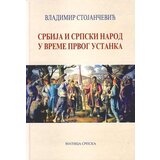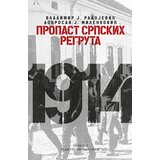Besplatna
registracija
Besplatna
registracija
Ne propusti prolećne popuste!
Sve za kuhinju
uz najveću uštedu!





PAVLE SOLARIĆ
The best editor of Pane Teodosije was Pavle Solarić. He was born on August 7, 1779, in Velika Pisanica near Bjelovar, in a respectable family that "provided six priests“, in a house that, in addition to foreign books, also contained the Serbian books, printed in Venice. He was educated in Križevci, Zagreb and Sremski Karlovci. He completed his studies in philosophy and law at the Royal Academy in Zagreb. From the Orahovica Monastery, the spiritual centre of the Serbs of Slavonska Podravina and Baranja, on the recommendation of Metropolitan Stratimirović, he went to Italy, with the intention of devoting himself to literature and science. In Padua, on December 10, 1803, he met Dositej Obradović and Atanasije Stojković, and from 1804, at their persuasion and recommendation, he started working as a proofreader and editor in the printing house of Pane Teodosije.
Solarić was a poet, he translated philosophical, geographical, historical and other texts and documents. He was a reformer of the Serbian language and orthography, a philologist, the author of the Serbian terminology in several scientific disciplines and the writer of one of the first Serbian histories of printing. He knew SlavicSerbian, Latin, German and the Serbian vernacular language. He died on Epiphany, January 18, 1821, in Venice.
BOOKS BY SERBIAN EDUCATIONAL REFORMERS
The Venetian printer of Greek origin, Dimitrije Teodosije, started publishing church books in the Serbian language in the printing house New GreekOrthodox Typography, or, as it is sometimes called, SlavicGreek Typography, founded in 1755 by the Venetian authorities. In order to "remove the mistrust of the Serbian clergy in books that come from the Catholic surroundings”, Teodosije wrote in his imprint that books were printed in Moscow, Kiev or Saint Petersburg, which was not entirely incorrect, because they were often reprinted church books in civil Cyrillic for the needs of the Serbian church. In about fifteen years (from 1761 to 1776) more than fifty books intended for the Serbs came out of his printing house. After the death of Dimitrije Teodosije, his successor and nephew, Pane Teodosije, continued to publish the Serbian books until around 1824.
The publishers Dimitrije and Pane Teodosije from Venice printed, in addition to sacred liturgical books, as Monika Fin writes, the civil works of the first Serbian educational reformers: Zaharije Orfelin, Atanasije Stojković, Dositej Obradović and Pavle Solarić.
Teodosije’s publishing house had an employed proofreader, a kind of editor of the Serbian publications. The editor was Zaharije Orfelin for some time, and after his departure to Vienna in September 1770, the position of the editor of Teodosije’s house was taken over first by the Greek Spiridon Ruđeri, and then by the most educated writer of the time, Pavle Solarić.
HRISTOFOR ŽEFAROVIĆ
From the mid18th century, copperplate artists Hristofor Žefarović and Zaharije Orfelin, an engraver, calligrapher, painter and writer, prepared copperplate editions with the material support of the church. According to Dejan Medaković, Žefarović published from 1741 to 1748 “the following books of exceptional importance for the Serbs“: in 1741, in collaboration with the engraver Thomas Mesmer, he published Stemmatographia, in 1742 one of his books, in 1745 Privileges, which followed after the Empress confirmed the Serbian privileges received from the Emperor Leopold and in 1748 the booklet by Simeon Simonović.
RUSSIAN CIVIL CYRILLIC ALPHABET
Firstly, Teodosije printed books in the Glagolitic script and, after purchasing another press, in the Illyrian script, in the Serbian language, in the Russian Civil Cyrillic Alphabet, which was introduced in the first decade of the 18th century by Emperor Peter I for the purpose of printing texts of a primarily secular character. Pavle Solarić, a collaborator of Pane Teodosije in the 19th century, in his preface to the Catalogue of the old editions of the Serbian books, claimed that Cyrillic letters were imported from Moscow, while Glagolitic letters were bought in Rome.
The most valuable books published by Teodosije’s publishing house were printed in the Serbian language, in the Illyrian script, in the Russian Civil Cyrillic Alphabet.
The first Serbian authors, whose works were printed in the “civil alphabet“ were Zaharije Orfelin, Dositej Obradović, Emanuilo Janković, Lukijan Mušicki and Sava Mrkalj.
JOSEPH LORENZ VON KURZBECK
After the Great Migration of the Serbs under Patriarch Arsenije Čarnojević in 1690 and the establishment of new parishes, the need for liturgical books grew rapidly. Along with other privileges, the Patriarch asked the Austrian authorities for permission to establish a printing house and for the Serbs to publish their books themselves, like all other nations in the Habsburg monarchy, without censors. The Austrian authorities refused both the abovementioned request and his request that was repeated in 1707. The requests of Metropolitan Vićentije Popović in 1721, Mojsije Petrović in 1731 and the agile Metropolitan Pavle Nenadović in 1750 to give the Serbs the right to print their books were also rejected, under the pretext, as stated by Jovan Skerlić, that such a printing house was “unnecessary and superfluous“, having the Jesuit Cyrillic printing house in Trnava. Nevertheless, in order to suppress the uncontrolled spread of books by the Venetian publishers, especially the Russian books, which were also represented in the Serbian schools in the 18th century, the Habsburg authorities made a decision in 1770 to grant exclusive privileges and a monopoly on book publishing for twenty years to the Viennese university bookseller Joseph Lorenz von Kurzbeck. Atanasije Demetrović Sekereš was appointed as a proofreader, a kind of editor, after a series of vicissitudes around finding a suitable person. Kurzbeck published 151 books from 1770 until 1792, when the printing of the Serbian books was taken over by Stefan Novaković, a Serbian court agent, by purchasing the printing house, to the general delight of the young Serbs on the rise. Most of them were of an ecclesiastical character, a little less school textbooks and manuals, then various acts of state bodies, panegyrics in praise of famous people, a small number of books from fine literature and in 1777 the first translation of a novel into the Serbian language (Belisarius by Marmontel, translated by Pavle Julinac). The first book printed in the printing house was Primer (1770), and the last one was Stihi o nedeli čest suboti priemšej (1792).
Serbs were not, as Jovan Skerlić claims in his History of New Serbian Literature, satisfied with Kurzbeck’s printing house. In addition to the general fear of the union, liturgical books printed in “infidel“ Vienna were received with utmost mistrust, while, at the same time, it was strictly forbidden to bring such books from Russia. This mistrust increased particularly from 1785, when Emperor Joseph made the decision that Cyrillic can only be used in ritual books, and that all other school textbooks and books of secular content had to be printed in Latin. Kurzbeck’s printing work was also unsound: paper was weak, the letters were bad, the spelling was wrong, the work was slow and the price of books was high.
STEFAN NOVAKOVIĆ
After purchasing Kurzbeck’s printing house, Stefan Novaković ambitiously started his publishing activities by announcing the publication of Rajić’s Istorija raznih slovenskih narodov, but he quickly ran into difficulties. Therefore, in 1795, he sold the printing house with all the accompanying privileges to the University Printing House in Pest, which was understood by the same young Serbs as a hard national defeat this time. In a few years of being engaged in publishing, Novaković, in addition to a series of liturgical books, books by Dositej, Domentijan, Reljković and Maksimović, published the first books in the Serbian language that were published by collecting subscriptions and renumbering. Novaković published over 200 books. The first published book was Bukvar radi serpskago junošestva v Hungarskom Kralevstve (1792), and the last one Trebnik (1795).
SLAVONICSERBIAN LANGUAGE
Until 1786, all books in Kurzbeck’s and Novaković’s “SlavicSerbian, Wallachian and Eastern languages’ typography“ were printed exclusively in church Cyrillic, in the old inherited type of Cyrillic letters from the middle century, and later with the modern “Cyrillic, the socalled civil alphabet, tailored according to the style of Latin printed letters introduced in Russia at the beginning of the 18th century by order of Peter the Great“. Moreover, all our books from 1494 until today were published in the Old Slavonic language, then in the Church Slavonic language of the Serbian recension, that is, in the SerboSlavic language, and from the 18th century in RussoSlavic and SlavicSerbian, which was in use until the beginning of the 19th century. Since the middle of the 19th century, when Vuk’s reform was accepted, all books have been printed in the modern Serbian language.
In the period from 1740 to 1780, according to Jovan Skerlić, an average of 2 books were published per year, from 1780 to 1800 7 books, from 1800 to 1820 19 bo
Grafikon prikazuje kretanje najniže cene proizvoda u izabranom vremenskom periodu.
Trenutno najbolja ponuda:
1.089,00 din u Delfi